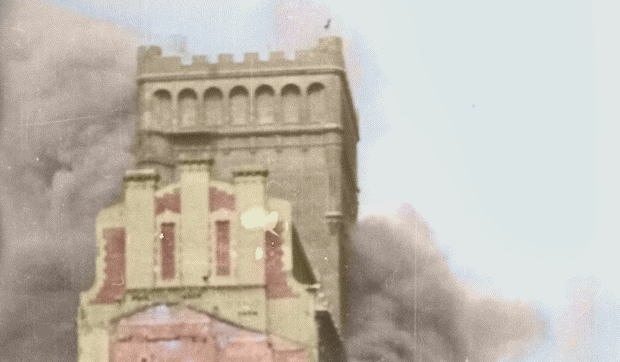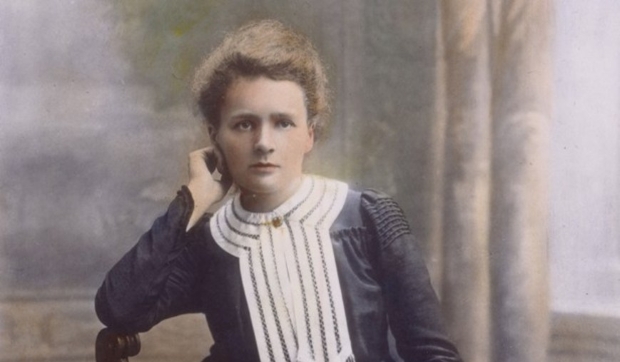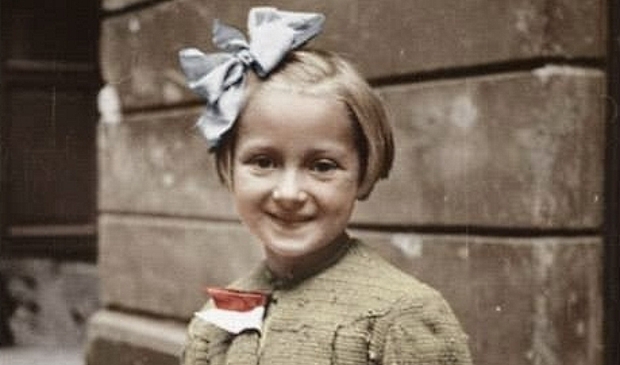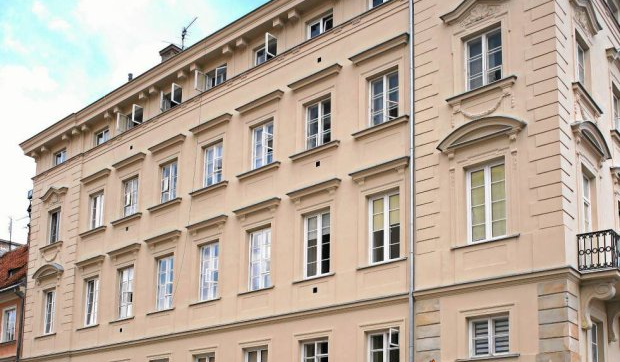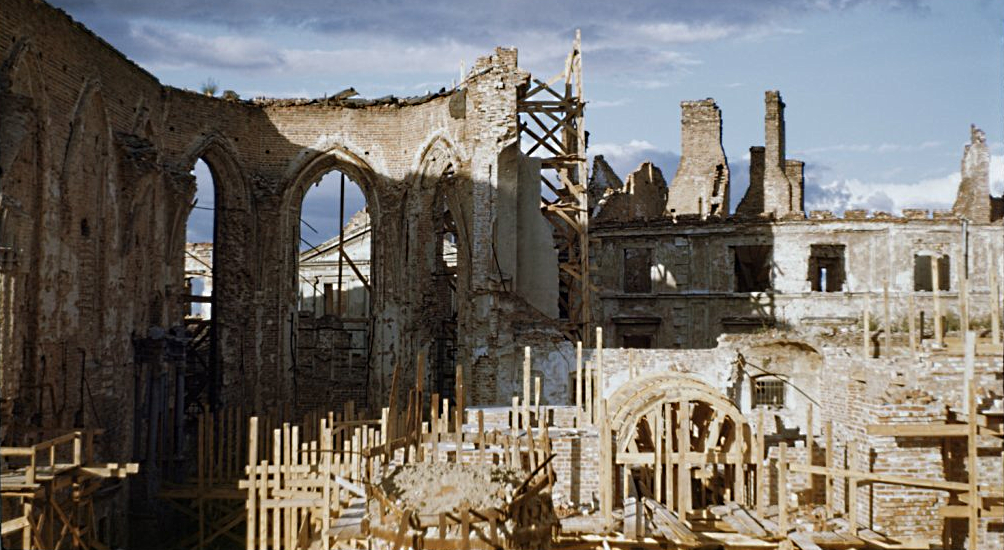
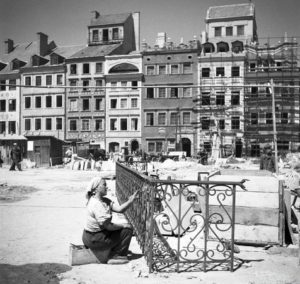 To fully appreciate the meticulous reconstruction of Warsaw, it is important to understand the extensive long range planning and extremely thorough destruction of the city from the early 1930’s through to its horrific culmination on January 17, 1945.
To fully appreciate the meticulous reconstruction of Warsaw, it is important to understand the extensive long range planning and extremely thorough destruction of the city from the early 1930’s through to its horrific culmination on January 17, 1945.
This will give a clearer sense of the challenge facing the rebuilders. One of the most detailed accounts complete with numerous eyewitness accounts has been provided by Alexandra Richie in her recent book Warsaw 1944 Hitler, Himmler, and the Warsaw Uprising. Here we will focus on the material destruction, but some mention must be made of the human loss, the loss of human capital, because these were the people and their culture that made Warsaw what it was. We will explain here the means of “complete”, because aside from the destruction of Carthage by Romans, this destruction was unique in the annals of history.
The Destruction
In the 1930’s teams of German scholars, architects and historians descend on the city to study which buildings could claim German ancestry and would therefore be worthy of preservation
After Nazi German occupation of Poland in 1939, Nazi engineer and architect Friedrich Pabst publishes a report Die Neue Deutsche Stadt Warschau which includes a section entitled Der Abbau der Polenstadt und der Aufbau der Deutschen Stadt (The Destruction of the Polish City and the Construction of the German City). The report concludes that every building must be destroyed except for the old town due to its Germanic burgher house, Lazienki Palace and the Belwedere palace that was to house the visiting Hitler. The population was to be reduced from 1.3 million to 80,000 Poles restricted to the Praga district and Warsaw proper would be build in the style of a medieval German town with a planned population of 130,000 Germans.
Bombing and new plan
The Luftwaffe bomb Warsaw heavily in 1939 to commence destruction. A new version of the Pabst Plan is drawn up by architects Hubert Gross and Otto Nurnberger to take this destruction into account. This plan is then presented to Hans Frank on February 6, 1940 entitled Neue Deutsche Stadt Warschau.
Clearing of Warsaw Ghetto
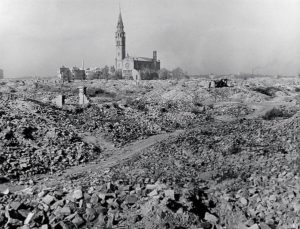 400,000 Jews, who greatly influenced the culture of Warsaw, are herded into this artificial ghetto and murdered within in or shipped to death camps from the Umschlagplatz. After ghetto riring in 1943 special troops burn down and blow every building in the area – that was over 30% of the city is turned into a brick desert.
400,000 Jews, who greatly influenced the culture of Warsaw, are herded into this artificial ghetto and murdered within in or shipped to death camps from the Umschlagplatz. After ghetto riring in 1943 special troops burn down and blow every building in the area – that was over 30% of the city is turned into a brick desert.
On August 5th and 6th 1944, the Destruction of Wola and Ochota and the massacre of 40,000 and 15,000 civilians respectively constitutes the largest single battlefield massacre in World War II. These Aktions were sanctioned by Hitler and Heinrich Himmler (Reichsfürher of the SS), led under direction of SS General Heinz Reinefarth with the ultimate order given by General von Vormann of the 9th Army to commence, then brutally executed in Wola by Oskar Dirlewanger and his gang of released murder convicts along with the rest of Kampfgruppe Reinefarth and in Ochota by Bronislaw Kaminski and his gang of eastern POWs and conscripts. Dirlewanger’s brigade was infamous for their brutality, raping and murdering women not even sparing children. Hitler awarded Dirlewanger the Knight’s Cross for his work here. The mausoleum in Sowinski Park in Wola today contains the 1,120 kilos of human ashes from this massacre.
The Old Town
 The destruction of Old Town, measuring about 10 square kms, utilized what were termed wunderwaffen, the most advanced and destructive weapons of the era. Generalfeldmarschall Robert Ritter von Greim sent hundreds of sorties of Stukas, Messerschmitts and Junker Ju-87Ds dropping 1,580 tonnes of bombs over the entire city. 711 Ju-87D sorties ordered by Oberleutenant Hans-Jurgen Klussman were sent over the Old Town alone. Panzer tanks were ineffective in the old town maze of streets, so the largest assault guns were deployed as of August 13th, namely 10 SturmPanzer IV or Grizzly Bears with 150 mm howitzers. Two monstrous 65 tonne Strumtiger with 380mm rocket launchers were added that sent gigantic 345 kg shells into the old town. To this arsenal was added over 40 Hetzer JagdPanzer 38s anti-tank guns with high velocity 75mm guns as well as 90 of the infamous Goliaths (one was restored and is on display at the Warsaw Uprising Museum), miniature tanks that carried up to 100 kgs of TNT and could be directed by remote control anywhere (one destroyed the 13th Century St. John’s Cathedral) and the Panzerzug 75 with 105mm howitzers. The latter was commanded by Captain Franz Eaon sending it back and forth along a track by Gdansk rail station on the edge of the old town, pounding it mercilessly with firepower.
The destruction of Old Town, measuring about 10 square kms, utilized what were termed wunderwaffen, the most advanced and destructive weapons of the era. Generalfeldmarschall Robert Ritter von Greim sent hundreds of sorties of Stukas, Messerschmitts and Junker Ju-87Ds dropping 1,580 tonnes of bombs over the entire city. 711 Ju-87D sorties ordered by Oberleutenant Hans-Jurgen Klussman were sent over the Old Town alone. Panzer tanks were ineffective in the old town maze of streets, so the largest assault guns were deployed as of August 13th, namely 10 SturmPanzer IV or Grizzly Bears with 150 mm howitzers. Two monstrous 65 tonne Strumtiger with 380mm rocket launchers were added that sent gigantic 345 kg shells into the old town. To this arsenal was added over 40 Hetzer JagdPanzer 38s anti-tank guns with high velocity 75mm guns as well as 90 of the infamous Goliaths (one was restored and is on display at the Warsaw Uprising Museum), miniature tanks that carried up to 100 kgs of TNT and could be directed by remote control anywhere (one destroyed the 13th Century St. John’s Cathedral) and the Panzerzug 75 with 105mm howitzers. The latter was commanded by Captain Franz Eaon sending it back and forth along a track by Gdansk rail station on the edge of the old town, pounding it mercilessly with firepower.
Major Reck set up rocket launchers in the Saski Gardens that could send 40 deadly 57kg incendiary bombs in as many seconds. On August 18th flamethrowers of the SS Jäger-Abteilung arrived along with a 61mm howitzer. Krone Battalion was brought in with 150 flamethrowers and the SS received a further battery of 105 and 150mm howitzers, two 210mm mortars and two 280mm howitzers. Then came the 120,000kg ‘Karl’ mortars (Karl Mörser Gerät), the largest self-propelled weapons in the history of warfare, with shells weighing 1,577 kilos each. 56 were fired from Sowinski Park alone, the concrete pad on which it was mounted still stands. This gun had the power to destroy an entire building and bury all of its residents. On August 15th Nebelwerfers rocket launchers were introduced. The shells emitted a terrible shriek and so were known as ‘Krowas” (cows), since they sounded like dozens of beasts in their death throes. Thousands of these shells were used, many filled with jellied petroleum causing horrendous burns – thousands died this way.
To be continued…
0 komentarzy
Zostaw odpowiedź
Musisz być zalogowany aby napisać komentarz.
